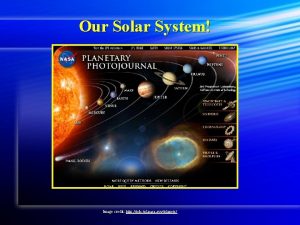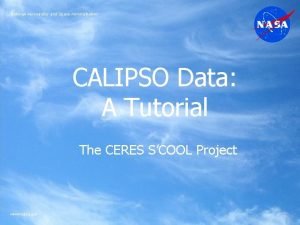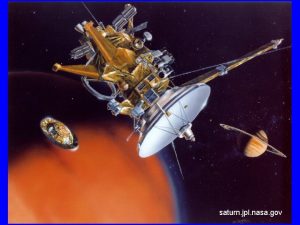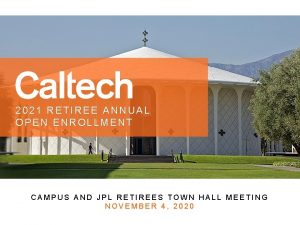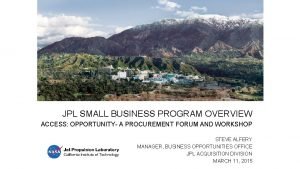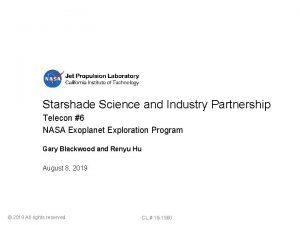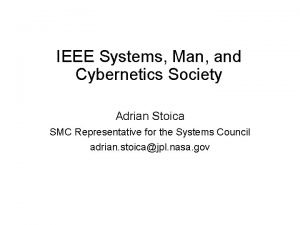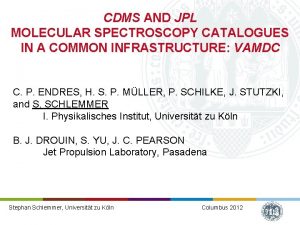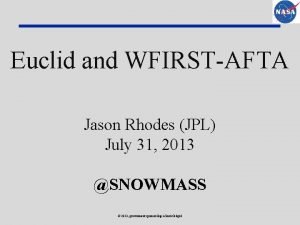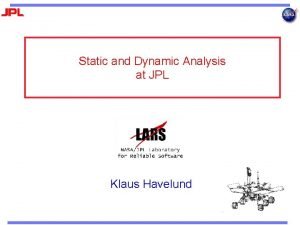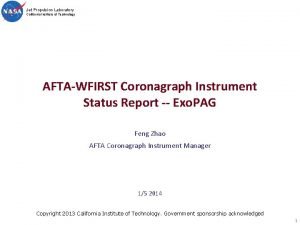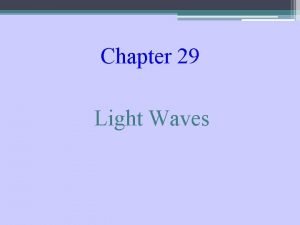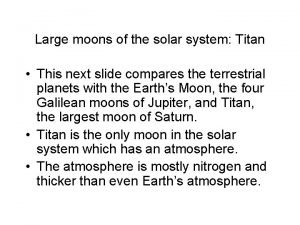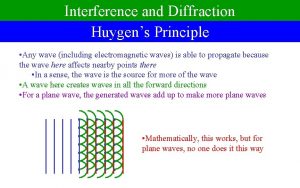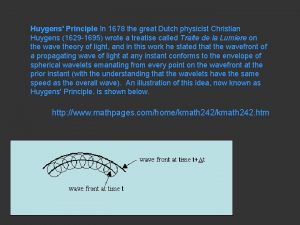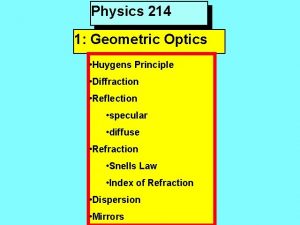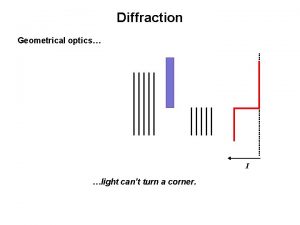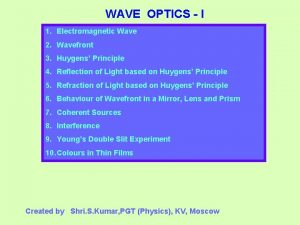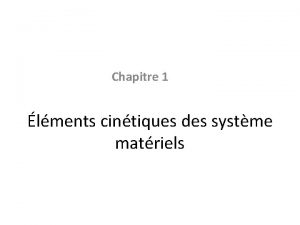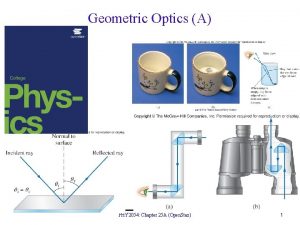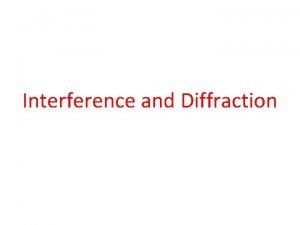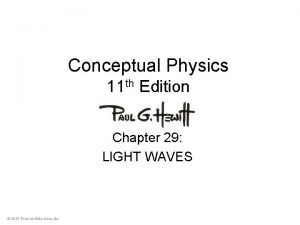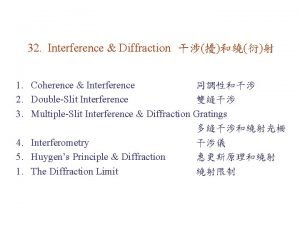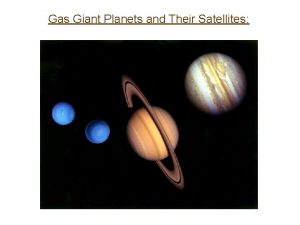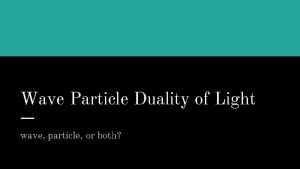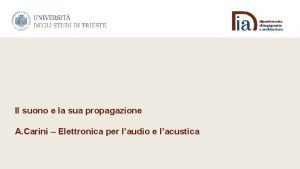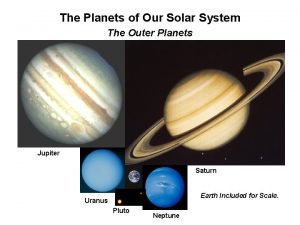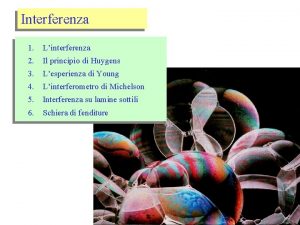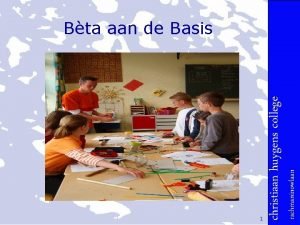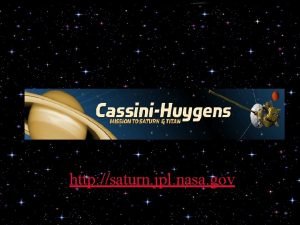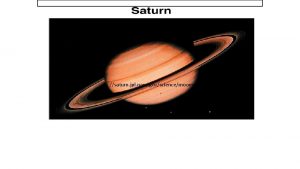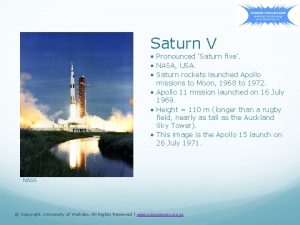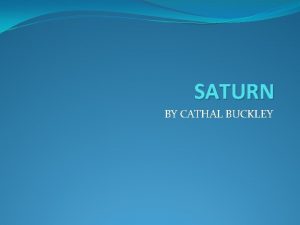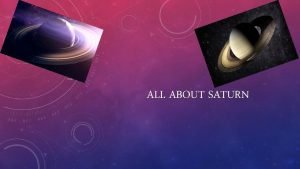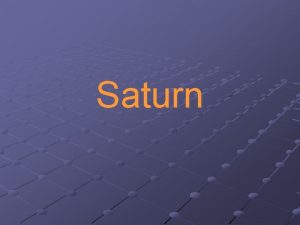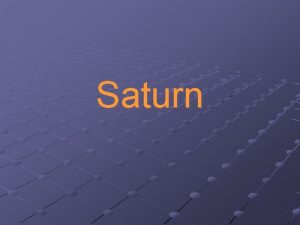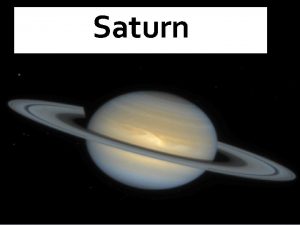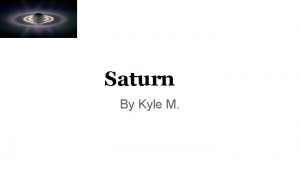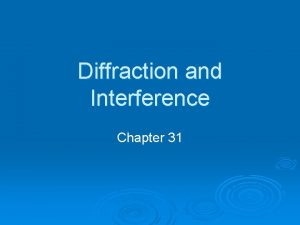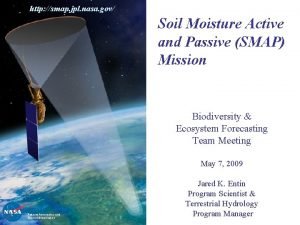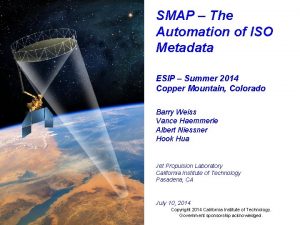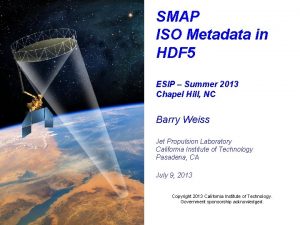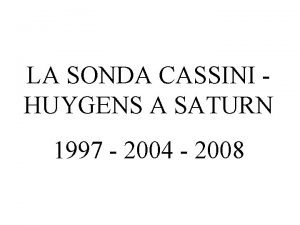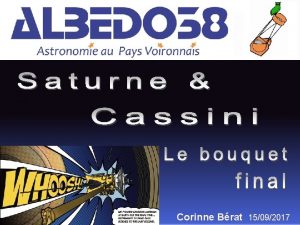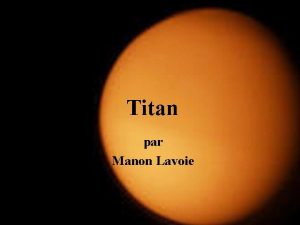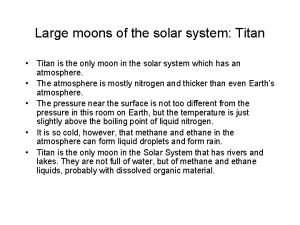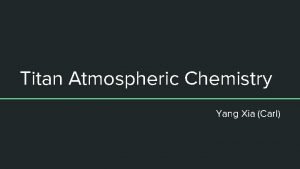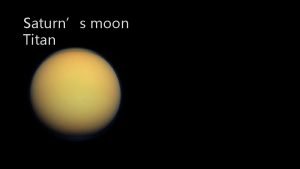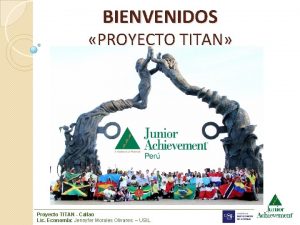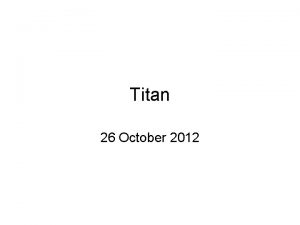saturn jpl nasa gov Huygens at Titan Paul

































- Slides: 33

saturn. jpl. nasa. gov

Huygens at Titan Paul Withers Boston University (withers@bu. edu) Titan – The big questions Huygens mission and instruments First results MIT EAPS Lunch Talk 2005. 02. 08

Why Titan? • Atmospheric chemistry and evolution • Analogue for Archean atmosphere • Prebiotic, organic chemistry involving atmosphere, surface, and interior • Veiled surface • Active geology? • Liquids and Earth-like geology?

saturn. jpl. nasa. gov

Teemu Makinen, FMI

photojournal. jpl. nasa. gov

photojournal. jpl. nasa. gov

Lebreton and Matson 2002

Titan’s Atmosphere • How has it changed over time? Primordial, recent, cyclic? • What is the source of methane? • Aerosols, hazes, and clouds • What is the chemistry like, especially organics? • Are dynamics like cyclostrophic Venus?

photojournal. jpl. nasa. gov

Lorenz (2003) Science, 302, 403 -404

saturn. jpl. nasa. gov

Titan’s Surface and Interior • Are or were liquids present? • Are there organic sediments from ethane/methane rain? • How active is surface geology – volcanoes, tectonics, fluvial processes, cratering? • What is mix of H 2 O, NH 3, rock in interior? • Subsurface ocean connected to surface?

1655, Christaan Huygens discovers that Saturn has a satellite, Titan 1659, Huygens proposes that Saturn is surrounded by a thin, flat ring galileo. rice. edu

www. esa. int?

• Play animateddescent 90 s. mov

saturn. jpl. nasa. gov

nssdc. gsfc. nasa. gov

Huygens Atmospheric Structure Instrument (HASI) • • Entry accelerometers - p, T(z) from 1270 km Direct p, T instruments Thermal balance, dynamics, waves Permittivity, wave, and altimetry – AC and DC fields, ion and electron conductivities, sound, electrical properties of surface, surface roughness • PWA looking at charged particles, lightning

Doppler Wind Experiment (DWE) • Line-of-sight wind below 200 km from (a) Cassini and (b) Earth-based radio scopes • Determine zonal wind speed, study dynamics of swinging probe, atmospheric turbulence • Requires ultrastable oscillator on one of Huygens’ two transmission channels

Gas Chromatograph Mass Spectrometer (GCMS) • Elemental and isotopic composition of gaseous atmosphere below 200 km • Range is 2 – 141 amu • Essential for atmospheric chemistry • C, N isotopes imply atmospheric evolution • Possibly analyze surface sample as well

Aerosol Collector Pyrolyser (ACP) • Pyrolyse aerosol particles from ~50 km and ~20 km altitude, feed to GCMS • Expect long chain hydrocarbons (CHNO) • Study cloud chemistry, compare condensed to gaseous abundances • Context for surface composition

Descent Imager/Spectral Radiometer (DISR) • 14 photometers, VIS/IR spectrometers, imagers • Surface images for geomorphology • Measure spectrum of upward and downward flux at two polarisations, monitor solar extinction • Thermal balance from fluxes, aerosol shape/size/distribution

Surface Science Package (SSP) • Design for impact in liquid or solid, many small experiments • Surface temperature, thermal conductivty, permittivity, refractive index, liquid density • Speed of sound in ocean • Sonar, plus tilt sensors for attitude/motion • Penetrometer to characterize impact • Plus same measurements during descent

saturn. jpl. nasa. gov

• Play descentcam. mov

saturn. jpl. nasa. gov

saturn. jpl. nasa. gov

saturn. jpl. nasa. gov

First Results • Successful entry, survived impact, lasted for hours on surface • One of two Cassini receiver channels not switched on, DWE got no data • Rely on ground-based tracking instead • 350 images returned, 350 lost • Several other instruments lost some data, but, overall, mission was highly successful

Not Pretty Pictures • p, T(z) as predicted, plus large (gravity? ) waves in upper atmosphere • 4 minutes entry, 2. 5 hour descent • 5 ms-1 impact, 15 g deceleration • Surface solid, stiff crust above weaker (wet sand-like) substrate – crème brulee • Clouds extended lower than expected (30 km, not 50 -70 km) • Liquid methane within few cm of surface

Pretty Pictures • Orbital images and radar hard to interpret, Huygens images are much easier • Very active surface, but no obvious liquids • Flow in channels, around base of pebbles • Dark areas are low-lying • Hydrocarbon rain inferred from channels

What Next? • • • More press releases – Media, web Conferences – LPSC, EGU, AGU Papers – 3 month Sci/Nat special issue Data Access – Eventually, probably Funding – NASA Cassini PS Program, Saturn DAP, plus usual sources • More data – Cassini tour continues, future Titan mission possible?
 Http://pds.jpl.nasa.gov/planets/
Http://pds.jpl.nasa.gov/planets/ Nasa www.nasa.gov
Nasa www.nasa.gov Paul huygens
Paul huygens 877-644-1774
877-644-1774 Jpl siri
Jpl siri Gary blackwood jpl
Gary blackwood jpl Adrian stoica jpl
Adrian stoica jpl Jpl molecular spectroscopy
Jpl molecular spectroscopy Jason rhodes jpl
Jason rhodes jpl Jpl c coding standard
Jpl c coding standard Jpl org chart
Jpl org chart Ito ay ang awit ng mga lasing.
Ito ay ang awit ng mga lasing. Principiul lui huygens reflexia si refractia undelor
Principiul lui huygens reflexia si refractia undelor Principiul lui huygens
Principiul lui huygens Huygens
Huygens Principiul lui huygens
Principiul lui huygens Huygens principle
Huygens principle Principiul lui huygens
Principiul lui huygens Fresnel lens vs convex lens
Fresnel lens vs convex lens Huygens principle of wavefront
Huygens principle of wavefront Christiaan huygens manometer
Christiaan huygens manometer Theoreme de huygens
Theoreme de huygens Huygens principle
Huygens principle Huygens principle
Huygens principle Huygens principle features wavefronts that are composed of
Huygens principle features wavefronts that are composed of Moment cinétique
Moment cinétique Huygens principle example
Huygens principle example Jovian gas giant
Jovian gas giant What is particles
What is particles Huygens pronuncia
Huygens pronuncia Huygens
Huygens Frangia chiara e scura
Frangia chiara e scura Historia de la luz
Historia de la luz Christiaan huygens college rachmaninowlaan
Christiaan huygens college rachmaninowlaan
